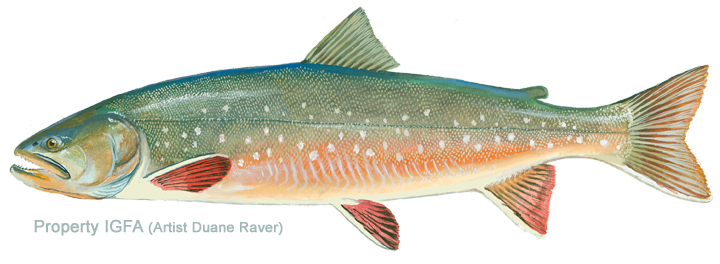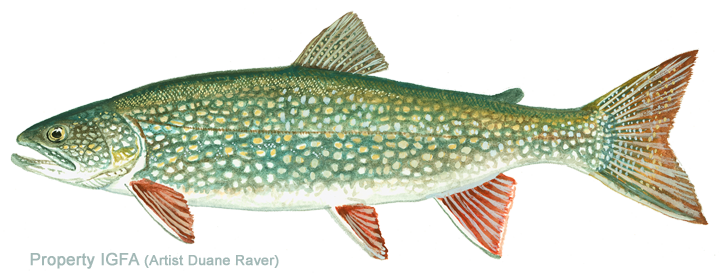Game Fish Identification Reference Guides
Dolly Varden
(Salvelinus malma)
(Salvelinus malma)

(Walbaum, 1792); SALMONIDAE FAMILY
Known to occur from the Sea of Japan through the Kuril Islands to Kamchatka, through the Aleutian Islands and around Alaska to the Yukon and Northwest Territories (Canada) in the north and the northwestern United States in the south. Like the Arctic char (Salvelinus alpinus), it is an anadromous fish (migrates to the sea and back), though some populations are landlocked.
The complex of chars composed of Arctic char (S. alpinus), Dolly Varden (S. malma) and bull trout (S. confluentus) is a closely related group and difficult to distinguish from external characteristics. Due to past misidentification of species in various locales and lack of scientific knowledge, much of the available literature on these species is either misleading or incorrect, and there is still some disagreement among scientists on their distribution.
The Dolly Varden and bull trout can generally be distinguished by their size and habitat. The Dolly Varden is usually a coastal species whereas the larger bull trout is found inland in large, cold rivers and lakes draining high, mountainous areas. A much greater problem arises in trying to separate the Dolly Varden from the Arctic char. Much published information on the distribution of these species is incorrect and often presupposed that only one species or the other occurred in areas or rivers where it is now believed both species may occur. The two are outwardly almost identical in every respect and to complicate matters, significant variations occurs in both species. The spots on the Dolly Varden are usually smaller than the pupil of the eye, while on the Arctic char they are larger than the pupil. When returning from the sea both species are silvery and lack spots. Arctic char on the average have more gill rakers on the first left gill arch (25 30 as opposed to 21 22 in the Dolly Varden) and more pyloric caeca (40 45 as opposed to about 30 in the Dolly Varden), but fish with intermediate counts (i.e., 23 or 24 gill rakers and 35 pyloric caeca) are not at all uncommon in either species.
Fish that don't clearly “fit the pattern” will almost certainly have to be examined in a laboratory to determine their identity. Since the problem of identification was only very recently even diagnosed, there are at present very few scientists who are qualified to make a positive identification on an unusual specimen. IGFA recommends that all potential record chars that cannot be positively identified by external characteristics be frozen in case further study is needed
Known to occur from the Sea of Japan through the Kuril Islands to Kamchatka, through the Aleutian Islands and around Alaska to the Yukon and Northwest Territories (Canada) in the north and the northwestern United States in the south. Like the Arctic char (Salvelinus alpinus), it is an anadromous fish (migrates to the sea and back), though some populations are landlocked.
The complex of chars composed of Arctic char (S. alpinus), Dolly Varden (S. malma) and bull trout (S. confluentus) is a closely related group and difficult to distinguish from external characteristics. Due to past misidentification of species in various locales and lack of scientific knowledge, much of the available literature on these species is either misleading or incorrect, and there is still some disagreement among scientists on their distribution.
The Dolly Varden and bull trout can generally be distinguished by their size and habitat. The Dolly Varden is usually a coastal species whereas the larger bull trout is found inland in large, cold rivers and lakes draining high, mountainous areas. A much greater problem arises in trying to separate the Dolly Varden from the Arctic char. Much published information on the distribution of these species is incorrect and often presupposed that only one species or the other occurred in areas or rivers where it is now believed both species may occur. The two are outwardly almost identical in every respect and to complicate matters, significant variations occurs in both species. The spots on the Dolly Varden are usually smaller than the pupil of the eye, while on the Arctic char they are larger than the pupil. When returning from the sea both species are silvery and lack spots. Arctic char on the average have more gill rakers on the first left gill arch (25 30 as opposed to 21 22 in the Dolly Varden) and more pyloric caeca (40 45 as opposed to about 30 in the Dolly Varden), but fish with intermediate counts (i.e., 23 or 24 gill rakers and 35 pyloric caeca) are not at all uncommon in either species.
Fish that don't clearly “fit the pattern” will almost certainly have to be examined in a laboratory to determine their identity. Since the problem of identification was only very recently even diagnosed, there are at present very few scientists who are qualified to make a positive identification on an unusual specimen. IGFA recommends that all potential record chars that cannot be positively identified by external characteristics be frozen in case further study is needed
















